NPS Website; Local Website
WHAT IS IT?
The Site formerly known as Platt National Park. The area includes stinky sulfur springs, rushing creeks, tiny Civilian Conservation Corps (CCC)-manufactured waterfalls, swimming holes and the man-made Lake of the Arbuckles, created in 1966 by the damming of Rock Creek. We did not visit the Arbuckle District; our review reflects only the Park’s historic Platt District.
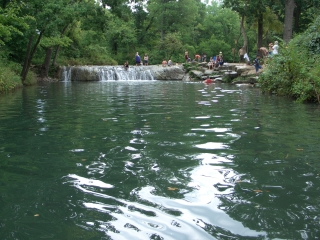 BEAUTY (6/10)
BEAUTY (6/10)Chickasaw NRA’s sturdy brick buildings and loosely manicured landscape enjoy a special rustic charm. The CCC boys designed and built the pavilions, trails, spring water fountains, waterfalls and the Travertine Nature Center. Nothing feels particularly natural or modern. Visiting the Park almost feels like stepping back in a time, to the 1930’s or 40’s, when the pace of life was slower, people were friendlier, water recreation meant swimming holes and shallow streams and people were not afraid to drink from natural water sources.
HISTORICAL INTEREST (3/10)
This area has been inhabited by Native Americans for at least 7,000 years. Archeologists are certain that they attributed healing powers to the sulphur water. In 1855 the land became a part of the Chickasaw Nations, displaced Indians who were given the land, then in the Indian Territory, after the U.S. Government forced them from their southeast U.S. Home.
In 1902, Chickasaw Nation gave the land surrounding the sulphur springs to the Federal Government with the agreement that it would be protected as a National Park. A stipulation to the agreement was that entry into the Park would always be free. Park entry remains free to this day.
The Park, then known as Platt National Park, was a part of the NPS before Oklahoma became a state (in 1907). Interestingly Senator Platt, from Connecticut, never visited the Park. In 1976, Platt NP was combined with the man-made Lake of the Arbuckles to create Chickasaw NRA.
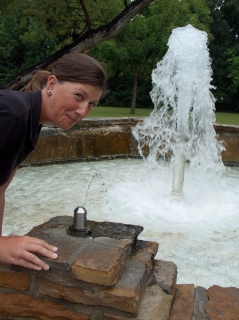 CROWDS (8/10)
CROWDS (8/10)Happiness is infectious. Swimming, laughing, diving, splashing, hooo weeee! Nothing is better than an old-fashioned swimming hole. In the blink of an eye, we were in the water and cooling off on a warm Saturday afternoon. Hordes of people were getting wet, enjoying the day. Conversation was natural, friendships were made, and everybody intermingled. What a great place.
Sulphur water drinking, however, is not infectious. We watched person after person, male and female, young and old fill the plastic gallon jugs with the spring water. Gab was our guinea pig. She tried them all. They got progressively worse. “What does it taste like,” Michael asked. “Warm rotten eggs,” Gab replied with an unmentionable look on her face. Michael passed and was thankful for his wife’s adventurousness.
EASE OF USE/ACCESS (4/5)
The Park is located about 75 miles southeast of Oklahoma City and 140 miles north of Dallas, Texas. The town of Ada, Okla., a crossword puzzle favorite is 38 miles to the northeast.
The town of Sulphur and the Park’s Travertine Nature Center is just 11 miles east of Interstate 35, Exit 55 along Oklahoma Route 7. Route 7 travels through Sulphur and turns into Broadway. Turn right at the corner of Broadway and 1st Street a/k/a U.S. Route177. The next left turn leads you on a short driving loop through the Park’s Platt District and straight towards the Nature Center.
Most of the Sulphur Springs are short turns off either Broadway or U.S. 177. At one point, we pulled off Broadway to examine our map only to realize that we had pulled into a National Park parking lot!
CONCESSIONS/BOOKSTORE (5/5)
A live male Barred Owl steadfastly watches over the Travertine Nature Center bookstore; his cage faces the books. The titles mirror the owl’s wise sensibilities. The Nature book choices are more, dare we say, down to earth than those found in western Parks. In place of hardcore rock climbing, how-to-use-your-GPS-system and climbing-14,000-foot peaks-type books are titles like The Work of Nature: How the Diversity of Life Sustains Us, Daniel Quinn’s Ishmael, Reconnecting With Nature and Sharing Nature With Your Children.
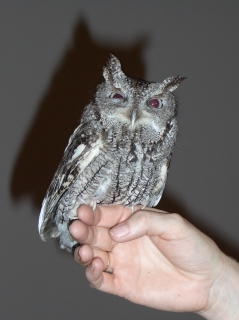 Unique children’s book selections include In the City (about raccoons and other clever beasts), Vanishing Animal Neighbors and Nature in Danger. The history titles have a distinct flair, like the WPA Guide to 1930’s Oklahoma, Indian Herbology of North America and Black Red and Deadly: Black and Indian Gunfighters of the Indian Territory. The store has successfully chosen quality over quantity.
Unique children’s book selections include In the City (about raccoons and other clever beasts), Vanishing Animal Neighbors and Nature in Danger. The history titles have a distinct flair, like the WPA Guide to 1930’s Oklahoma, Indian Herbology of North America and Black Red and Deadly: Black and Indian Gunfighters of the Indian Territory. The store has successfully chosen quality over quantity.The store also sells ceramic cork-stop jugs embossed with a Platt National Park logo. You can use it to gather the Park’s famed water.
COSTS (5/5)
The Park is free and in the summer, free Ranger-led talks are a common sight.
RANGER/GUIDE TO TOURIST RATIO (5/5)
Not only were there many Rangers, but they all were locals. Every Ranger we talked to had either grown up in the area or spent most of their lives here. They all spoke about the Park with reverence; they love its streams, waters, wildlife and even the Museum with all of their hearts. It is rare to see anyone express such passion towards a physical place let alone every person on staff.
TOURS/CLASSES (8/10)
The Travertine Nature Center is full of life. Dozens of kids, their bare feet still wet from wading, scurry around the unfinished floor stopping only to study a panel of peer into an aquarium. A Barred Owl is perched near the welcome desk and a tiny Screech Owl makes his home in the Rangers’ office. Standard-sized aquariums are everywhere teeming with life: all types of fish, insects and snakes.
A pair of live rattlesnakes, for decades the Nature Center’s most famous and most loved denizens, are now gone. The National Park Service, in their eminent wisdom, decided that the snakes were too much of a liability risk and had to be released back into their wild. Years of shed rattler skin remains, some in fancy cases, others at the terrific touch me table. A chart shows the once kept rattlers eating habits; did you know that they only eat about five times an entire year?
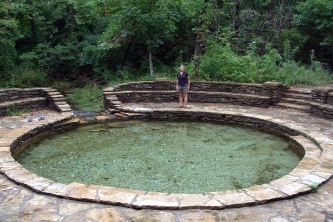 We stayed inside the Nature Center for an impromptu Ranger talk about owls. The scheduled for 20-minutes talk rambled on well over an hour because the Ranger could not stop talking about how much he loved his Park. A 4-H club leader concurred and they shared stories about fishing in the former Platt National Park. A 4-H student answered all nature questions with lighting-fast accuracy, as in: “Son, how did you know all Oklahoma’s poisonous snakes?” “Cause we got ‘em all in my backyard.”
We stayed inside the Nature Center for an impromptu Ranger talk about owls. The scheduled for 20-minutes talk rambled on well over an hour because the Ranger could not stop talking about how much he loved his Park. A 4-H club leader concurred and they shared stories about fishing in the former Platt National Park. A 4-H student answered all nature questions with lighting-fast accuracy, as in: “Son, how did you know all Oklahoma’s poisonous snakes?” “Cause we got ‘em all in my backyard.”The talk’s crescendo came was the appearance by the Screech Owl. Who knew they were such darling creatures; especially when they open their tiny beak and squawk inches from your face.
FUN (8/10)
Our original National Parks itinerary did not include National Recreation Areas, but somehow we managed to visit all of the NRA’s west of the Mississippi River. For the most part, they have been uneventful man-made lakes, fun for local boat owners but not special vacation stops for outsiders. We had forgotten about Chickasaw NRA and wanted to skip it altogether. A cursory glance at his history revealed that it was one of the original National Parks. “Shoot,” we thought. We gotta go.
We are so glad we did. Our day in the Chickasaw NRA’s Platt District was f-u-n, fun. We sampled sulphur spring water (ick) and waded in rushing springs while schools of fish surrounded our legs. We hiked through the thick Oklahoma forests past CCC-built stone buildings and scampering armadillos. We took in a terrific talk at the Nature Center, got up close and personal with owls and met some great Oklahoma people.
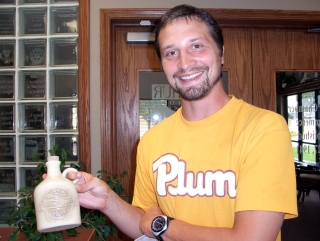 WOULD WE RECOMMEND? (6/10)
WOULD WE RECOMMEND? (6/10)On October 15, Chickasaw NRA is holding a songwriter’s contest celebrating the Park’s centennial. The goal is to write a song related to the Park’s long history. How cool is that? It just goes to show that Chickasaw NRA exists for the people. The Park feels lived in, appreciated and loved. A visit here is a perfect respite from the hot Oklahoma summer. Don’t plan a vacation to the Sooner State around Chickasaw NRA but do detour and stop in if you are making the drive between Dallas and Oklahoma City.
TOTAL 57/80
www.usa-c2c.com
© 2004-06